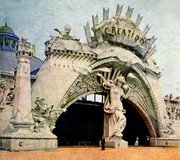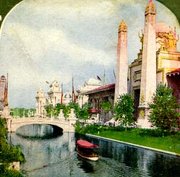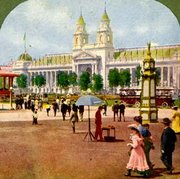Louisiana Purchase Exposition
|
|
Worlds-fair-st-louis-1904.png
The Louisiana Purchase Exposition, informally known as The Saint Louis World's Fair, was a World's Fair held in Saint Louis, Missouri in 1904 which celebrated the centennial of the Louisiana Purchase (delayed one year). It opened April 30, 1904, and closed December 1 the same year.
The Fair Grounds covered 1,200 acres (4.9 km²) roughly on the present-day grounds of Forest Park, the largest space of any fair, and it was probably the most grand of the old-style Pre-World War I Fairs. There were over 1500 individual buildings, connected by some 75 miles (120 km) of roads and walkways, and it was said to be impossible to give even a hurried glance at everything there in less than a week. The Palace of Agriculture alone covered some 20 acres (324,000 m²) of space.
All but one of the grand neo-Classical exhibition palaces were temporary, constructed with a material called "staff", similar to plaster of Paris. Buildings and statues suffered visible deterioration during the months of the fair. The single exception was the Palace of Fine Art, designed by architect Cass Gilbert and featuring a grand interior sculpture court based on the Roman Baths of Caracalla. Standing at the top of Art Hill, this building is among the remnants of the Fair and now serves as the home of the St. Louis Art Museum. Other structures dating from the Fair are Brookings Hall on the campus of Washington University, some of the mansions on Lindell on the north border of Forest Park originally built as national exhibits, and the huge bird cage at the St. Louis Zoo.
Exhibits were staged by 62 foreign nations, the United States government, 43 of the U.S. states, in addition to the numerous exhibits put on by many industries, cities, private organizations and corporations, theater troops, music schools, etc. Carnival-type amusements were found on "The Pike".
04ObservationWheel.JPG
The Fair hosted the 1904 Summer Olympic Games, the first Olympics held in the United States. These games had originally been awarded to Chicago, but when St Louis threatened to hold a rival international competition, the games were relocated. Nonetheless, the sporting events, spread out over several months, were overshadowed by the Fair. With travel expenses high, many European athletes did not come. Nor did Baron Pierre de Coubertin.
A number of foods are claimed to have been invented at the Fair, including the hamburger, the hot dog, peanut butter, iced tea and the ice cream cone. However, these claims are controversial and widely disputed.
Ragtime music was popularly featured at the Fair.
Birmingham, Alabama's iconic cast iron Vulcan statue was first exhibited at the Fair in the Palace of Mines and Metallurgy.
This Fair is referenced in the 1944 Judy Garland movie "Meet Me In St. Louis".
External links
- Online Exhibition by the Missouri Historical Society (http://mohistory.org/content/fair/wf/html)
- Homepage of the 1904 World's Fair Society (http://www.1904worldsfairsociety.org/index.htm)
- Virtual Tour of the 1904 World's Fair (http://www.crawforddirect.com/worldfairtour.htm)
- Online Version of 1904 Illustrated Guide to the Fair (http://washingtonmo.com/1904/index.htm)
- Website for Forest Park (urban park located roughly on the site of the fair) (http://www.slfp.com/ForestPark.html)
- Louisiana Purchase Exposition collection at the University of Delaware Library (http://www.lib.udel.edu/ud/spec/exhibits/fairs/louis.htm)
- Another online exhibit of fair memorabilia (http://www.bitwise.net/~ken-bill/fair.htm)
- An Edison company film of the Asia pavilion (http://hdl.loc.gov/loc.mbrsmi/awal.0659), at the Library of Congress



